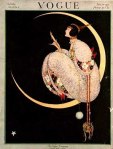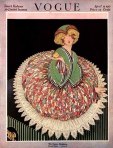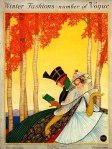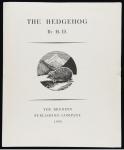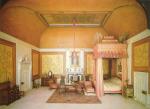Note: Since this piece appeared on line, I received a note from Arnold I. Kisch, Guido Bruno’s nephew, who published the following book about his uncle: The Romantic Ghost of Greenwich Village: Guido Bruno in His Garret. Frankfurt am Main: Peter Lang, 1976.
The book is out of print but WorldCat lists it in 36 American research libraries and another 15 elsewhere. Google Books reports the existence of the book but in a “no preview” format which means that there is no direct online access to it.
From his “Garret” at 58 Washington Square South, the colorful Villageois Guido Bruno published the periodicals Bruno’s Weekly, Bruno’s Bohemia, Bruno’s Monthly, Greenwich Village and a series of chapbooks, all sold for a few cents, from about 1913 to about 1917. Moore visited his studio on her fabled trip to New York in December, 1915 (see SL, pp. 111-112); she came away with Alfred Kreymborg’s Mushrooms, copies of the Weekly, and tickets to the Thimble Theater. Bruno included her short poems “Holes Bored in a Workbag by the Scissors” and “Apropos of Mice” in his Weekly in October, 1916. Moore might have found Bruno the self-promoter, courter of the intersection of free speech and indiscretion, less than likeable, but she could not have missed his impact on the Village and beyond. He had been, and in spirit continued to be, part of the place she moved to when she first had a choice in 1918: 14 St. Luke’s Place, Greenwich Village.
Bruno busied himself about the Village, holding art openings for Clara Tice and other in his garret, managing Charles Edison’s Thimble Theatre on  Fifth Avenue, across from the Brevort Hotel, planning for publications rather than statues as monuments to American composers like Stephen Foster. His devotion to Djuna Barns led to his publishing her chapbook, The Book of Repulsive Women: 8 Rhythms and 5 Drawings in 1915. Other chapbooks featured work by Kreymborg, Oscar Wilde, Sadakichi Hartmann, and Hubert Crackanthorpe.
Fifth Avenue, across from the Brevort Hotel, planning for publications rather than statues as monuments to American composers like Stephen Foster. His devotion to Djuna Barns led to his publishing her chapbook, The Book of Repulsive Women: 8 Rhythms and 5 Drawings in 1915. Other chapbooks featured work by Kreymborg, Oscar Wilde, Sadakichi Hartmann, and Hubert Crackanthorpe.
Fire destroyed his garret in 1916, taking with it a 68-page manuscript by G. B. Shaw, but Bruno continued to ply his literary and “anarchist” interests, mounting Strindberg plays at the Thimble, raising funds of $25,000 to free Emma Goldman from prison, contributing to Pearson’s Magazine along with Floyd Dell and Upton Sinclair. Such was his fame that mention of him turns up in papers widespread as the Appleton (Wisconsin) Post Crescent, The San Antonio Light, and The Corning (N. Y.) Evening Leader in addition to many mentions in the New York papers. As Maurice Zolotof wrote in the New York Times in 1939, Bruno broke down the insularity of the Village and, through his publications, made its citizens self-conscious.
 He also made them aware of him. Charles Sumner’s vice squad brought him up on charges for publishing Kreymborg’s Edna: A Girl of the Streets, meant as a commentary on the evils of prostitution. Frank Harris, editor of Pearson’s Magazine and himself notorious for sexual explicitness, testified that the book had not titillated him. Sumner confiscated 350 copies of the book and 150 advertising flyers, but did not have Bruno arrested. Bruno, however, claimed bankruptcy in 1917 when he sued Sumner for $100,000 damages.
He also made them aware of him. Charles Sumner’s vice squad brought him up on charges for publishing Kreymborg’s Edna: A Girl of the Streets, meant as a commentary on the evils of prostitution. Frank Harris, editor of Pearson’s Magazine and himself notorious for sexual explicitness, testified that the book had not titillated him. Sumner confiscated 350 copies of the book and 150 advertising flyers, but did not have Bruno arrested. Bruno, however, claimed bankruptcy in 1917 when he sued Sumner for $100,000 damages.
By that time, America was at war in Europe and the Villiage that Bruno celebrated had begun to change. In 1919, he wrote a piece later published in his Adventures in American Bookshops (1922):
The fad of false Bohemia in Greenwich Village has passed. The purple and orange brand of tearooms and of so-called gift shops where art lovers and artistic people from the Bronx and Flatbush assembled, have gone out of existence. The designers and manufacturers of astounding atrocities who called themselves “modern artists” have disappeared. True there are a few short-haired women left, who parade the streets in their unusual clothes, but they, too, will soon move to other parts of the city with the return of the soldiers, and will reassume their real calling in life.
False Bohemia, indeed. The original Guido Bruno, Kurt Josef Kisch, was born in Mlada Boleslav, Bohemia, on October 15, 1884. His father, the distinguished Rabbi Alexander Kisch, served a congregation in that town from 1881-1886 before returning to Prague; a professor with a doctorate from the University of Breslau, Rabbi Kisch later taught such literary luminaries as Max Brod and Franz Werfel.
Young Kurt sailed for New York in 1906 aboard the Dalmatia. He arrived on December 20, a medical student bound for Chicago probably to study  with his uncle, Dr. William Mislaf (or Mitzlaff), who was an ear and eye specialist on North Clark Street. He married Ragna Pauluda, recently of Norway, about 1909, and practiced medicine on Cass Street in Detroit, where he was named Curt Joseph Kirch by the 1910 census taker. Soon, this “Kirch” publishes a 21-page essay, “Der Holländisch-Deutsche zweig der Familie Washington und einige Washington-Dokuments” in the 1912 Jahrbuch Der Deutsche-amerikanischen Historischen Gesellschaft Von Illinois, (Vol. 12, Chicago, 1913). Largely a list of Washington family relatives with Dutch-German connections, the essay includes a letter from Martha Washington about a proposal for a Washington Monument. At about the same time, Curtis J. Kirch appears as editor of The Lantern: A Publication of Discarded Truth and Rejected Fiction. A Chicago product, it was edited with Milton Fuessle from January to July, 1913.
with his uncle, Dr. William Mislaf (or Mitzlaff), who was an ear and eye specialist on North Clark Street. He married Ragna Pauluda, recently of Norway, about 1909, and practiced medicine on Cass Street in Detroit, where he was named Curt Joseph Kirch by the 1910 census taker. Soon, this “Kirch” publishes a 21-page essay, “Der Holländisch-Deutsche zweig der Familie Washington und einige Washington-Dokuments” in the 1912 Jahrbuch Der Deutsche-amerikanischen Historischen Gesellschaft Von Illinois, (Vol. 12, Chicago, 1913). Largely a list of Washington family relatives with Dutch-German connections, the essay includes a letter from Martha Washington about a proposal for a Washington Monument. At about the same time, Curtis J. Kirch appears as editor of The Lantern: A Publication of Discarded Truth and Rejected Fiction. A Chicago product, it was edited with Milton Fuessle from January to July, 1913.
The migration from Kisch to Kirch to Guido Bruno was complete by the time the man reached Greenwich Village. His final name derived from the first names of his two brothers. Guido Kisch (1889-1985), was a professor of legal history at the University of Leipzig, Hebrew Union College in New York, and Basel University. Bruno Kisch (1890-1966) was a cardiologist who studied at the University of Cologne and worked at Yeshiva University in New York, studied the electron microscope at Yale, and retired to Bad Nauheim, Germany. Guido Bruno, however, never forgot his original name: his World War I draft registration card bears the following: Name—Guido Bruno; legal name—Josef Kurt Kisch, all in his own handwriting.
Post-Village, Bruno wrote for Pearson’s Magazine and continued to publish his own work, notably Adventures in American Bookshops, Antique Stores, and Auction Houses (Detroit: Douglas Bookshop, 1922). This work bears evidence of the experienced bookman; it describes antiquarian booksellers and their shops in Chicago, Detroit, New York and Boston with understanding. Back in his garret days, he demonstrated the heart of a bookman with an exhibition of European and American bookplates, supplemented by his talk on the romance of the bookplate. He owned the Union Square Bookshop at 30 E. 14th Street in New York in 1929 when he was underbidder to Dr. A.S.W. Rosenbach’s $2,500 for Articles of Agreement: Made and Concluded . . . . Philadelphia: Benjamin Franklin, 1733.
Bruno gradually moved out of range of the Village, first to Pelham Manor in Westchester County, then to Lower Merion, Pennsylvania where his adopted daughter, Eleanore, owned the American Autograph Shop in Marion Station. He became a naturalized American citizen in 1928 and registered for the World War II draft. The New York Times reported on January 27, 1943:
Bruno, Guido. Author, publisher, editor, journalist and historian [died s]uddenly, aged 58, at his daughter’s home in Merion, PA., leaving his widow, Ragna Bruno; daughter, Eleanore, and [her] son, Ragnar. Interment private.






